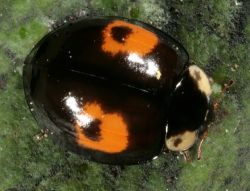A walk on the wild side
As the shortest days of the year approach, many insects have entered hibernation. We have previously suggested looking out for clusters of ladybirds gathering in nooks and crannies to spend the winter.
 David Harper, Life Sciences
David Harper, Life Sciences
 David Streeter, Life Sciences
David Streeter, Life Sciences
When we wrote that column (22 October 2004), the most common species in these hibernating clusters on campus were the dainty little Two-Spot Ladybird Adalia bipunctata and the larger (and commoner) Seven-Spot Ladybird Coccinella septempunctata.
Two years later (6 October 2006) we reported with concern the arrival on campus of the even larger Harlequin Ladybird Harmonia axyridis. This East Asian species is a voracious predator of aphids.
Harlequins are not easy to identify because they are incredibly variable in colour. Most can be described as belonging to three main forms: red or orange with a variable number of black spots (known as form succinea); black with four uniformly red spots (form spectabilis); and
 Conspicua morph ladybird
Conspicua morph ladybird
black with two red spots, each marked with a black spot (form conspicua; see photograph).
Our worry in 2006 was that the new arrivals might out-compete the native species for food and even eat their larvae. Our fears seem to have been justified.
This autumn, final-year undergraduate Karl Stone has been monitoring the changes in insect abundance on campus as winter sets in. Part of his work has involved monitoring ladybirds as they enter their winter roosts in metal railings near Sycamore trees by the JMS and Pevensey II buildings. He found just five Seven-Spots and one Two-Spot, but over 100 Harlequins, mainly succinea with some conspicua and spectabilis (and one odd-ball with irregular markings).
The massive predominance of Harlequins is alarming, but needs further investigation. The first atlas of Britain and Ireland’s ladybirds, published in June this year, suggested that seven of our 26 native ladybirds have declined since 2003, when Harlequins probably arrived in Britain. These seven, however, did not include Two-Spot or Seven-Spot Ladybirds.
Most Two-Spots and Seven Spots have bright scarlet wing-cases with the appropriate number of black spots on the two combined. Their bright colours, which advertise their foul taste to predators, meant that ladybirds were traditionally viewed as luck-bringers. If one lands on you, folklore holds that good fortune will follow so long as the insect flies off unharmed of its own accord (possibly encouraged by blowing gently). In particular, sick people who released a ladybird were meant to have their illness carried away. Quite why the beetle was told to “fly away home, your house is on fire and your children are gone” is unclear to us.
For young people, having a ladybird land on your hand was meant to indicate imminent marriage (something we forgot to mention to Karl). There were special instructions for ladies: the direction in which the ladybird flew off was meant to indicate the direction from which her future husband would arrive.
